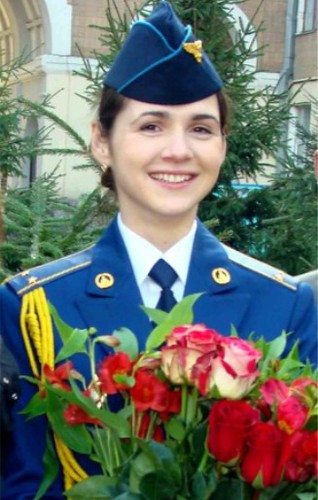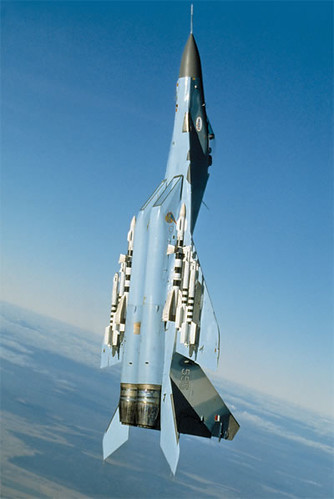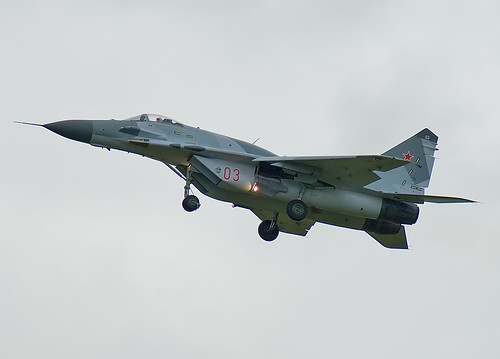





this is the second prototyp of the carrier variant of MIG-29 at soviet union, the tail number is 312, first prototyp 311
MIG-29SMT with modern russian missiles R27Et
This cockpit layout is for the Indian navy MIG-29K, the LCD`s are made in Russia from Ramenskoje Design Bureau
former prototyp of the soviet MIG-29M, tailnumber 156

Cannot identify yet those gray cannisters and the black pod in the left, but in the right we are seeing a Kh-29T air-to-ground missile, two R-27 missiles (AA-10 Alamo, not sure about version, but probably R-27T), a R-73 (the famous AA-11 Archer) and a general purpose FAB bomb (250 or 500, not sure).The left R-27 is the radar homing missile and the right one the IR homing ( to identify with the red safety cap on the head for the IR-sensor eye ).The versions with extended firing range is identify on the thicker last third missile body ( bigger diameter ). This versions carry the letter E in the missile name: R-27ET for IR and R-27ER for radar
Belarus modernized MIG-29BM R27er CH 29t missiles
MIG-29SMT cockpit
























3 comments:
The MIG-29's armament consist of a 30-mm gun and 6 "Air-to-air" missiles each with an infrared (heat-seeking) and radar homing head controlled independently
1 x 30mm Cannon
Standard air-to-air Armament:
2 x AA-10 Alamo Vympel R-27
4 x AA-11 R-73 AAMS OR 4 x AA-8 OR 4 x AA-12 Adder R-77 AAMs
6 x Underwing hardpoints can carry max load of 8,818lbs (4,000kg) of stores. Munitions may include the following:
various laser-guided / iron bomb loadouts.
air to surface missile
Kh-25M (AS-12 "Kegler"), Kh-29L/T (AS-14 "Kedge"), Kh-31A/P/RE (AS-17 "Krypton"), Kh-66 ("AS-7 Kerry") ASMs
Westerners got their first close look at the new MiG in July 1986 when a group of six MiG-29s visited Rissala Air Base in Finland. Soviet Air Force pilot Vladimir Chilin headed skyward in his MiG-29 after a takeoff run of only 1,600 feet. His acrobatic performance began immediately with a dynamic vertical climb followed by an extensive repertoire of maneuvers. The capability of the aircraft behind the impressive exhibition was not lost on the various military representatives in the crowd.
The MiG-29 is powered by two 18,300-pound-thrust (in afterburner) Isotov RD-33 turbofan engines. These engines provide the aircraft with a thrust-to-weight ratio of 1.2 to 1.
the MiG-29 was displayed at Great Britain's Farnborough Air Show as the first high-performance Russian fighter Two years later. It flew daily routines that included a slow-speed pass at approximately 120 miles per hour and an angle of attack of about twenty-five degrees. (MiG bureau representatives later claimed the aircraft is capable of a maximum AOA of thirty degrees.) The aircraft also demonstrated 360-degree turns in less than sixteen seconds and a sustained dynamic loading of nine g's.at the Paris Air Show the following year. Flying just over 100 miles per hour at an altitude of about 500 feet, the right engine stalled and the Russian pilot had to eject. As his K36DM ejection seat exited the cockpit, the aircraft rolled towards its starboard side and then descended in an almost perfect nose-first vertical attitude. Less than two seconds after Kvotchur punched out, the aircraft crashed to the ground. Kvotchur's parachute opened fully the moment his feet touched the ground. He suffered only minor injuries during the spectacle, which turned out to be one of the more persuasive emergency egress demonstrations in Paris Air Show history.Both single- and two-seat MiG-29s have been built in several versions. All are equipped with zero-zero ejection seats. The aircraft has a conventional cockpit arrangement with basically analog instrumentation and standard stick and rudder pedal controls. The cockpit is slightly elevated for improved visibility and is enclosed by a laminated, stretched acrylic canopy and a single-piece glass windscreen. The aft canopy of the two-seat aircraft has a retractable forward-viewing periscope mounted top and center for use by the backseater. A combining glass for a head-up display is mounted above the instrument panel. (The two-seat aircraft has no aft-seat HUD.) Some MiG-29s are equipped with a helmet-mounted sighting system integrated with the weapon system.
The MiG-29M, flown for the first time in 1989, has a sophisticated quadruplex digital fly-by-wire flight control system and an upgraded "glass" cockpit with cathode-ray tube multifunction displays. It is also equipped with upgraded engines, improved aerodynamics, and other subtle changes to optimize performance.
The most common late-production MiG-29 is the Fulcrum-C. This version carries extra fuel and upgraded avionics in the additional space provided by its distinctive dorsal hump. This version purportedly has an improved ground-attack capability, a mission for which the MiG-29 originally was not intended.
Actual carrier trials aboard the Russian aircraft carrier Admiral of the Fleet Kuznetsov (formerly the Tbilisi) began in 1989. Dubbed the MiG-29K ("K" means ship-based), the navy version is equipped with strengthened landing gear, folding outer wing panels, a tail hook, a thermal imaging sensor ball in place of the standard IRST unit, and miscellaneous other carrier-compatible systems and upgrades.
The MiG-29 Advanced Frontline Fighter along with the Su-27 were developed to counter new American fighters such as the F-15 Eagle, and the F-16 Fighting Falcon.While the heavy, long range Su-27 was tasked with dangerous role of deep air-to-air sweeps of NATO airplane like F15, the smaller MiG-29 was tasked with providing air superiority . Rugged landing gear and protective intake grates meant the MiG-29 could operate from the damaged or under-prepared airstrips Soviet war planners expected to encounter during a rapid armored advance.
Developed in the 1970s by the Mikoyan design bureau, the first prototype made its first flight on Oct. 6, 1977. U.S. reconnaissance satellites detected the new fighter in November 1977, and NATO gave it the designation "Fulcrum."
it entered service with the Soviet Air Force in 1983
The new Russian fighter first surfaced outside US intelligence agencies in 1979. It was initially known as "RAM-L" in consideration of early reconnaissance satellite photos showing an aircraft of unknown origin at the Ramonskoye (now Zhukovsky) flight test center.
Mig-29 is comparable to the F-16 but edging it out in performance
The Mig has better range,faster (not by much),has a higher ceiling
The Mig has a better climb rate
The Mig has a a 30mm cannon compared to the F-16s 20mm Vulcan
The Mig has 2 engines
MIG 29 pilot have done some dogfights with Dutch F-16s and found out that within a dogfight range of speed a typical series MiG-29 is able to outmaneuver with a F-16A without radar and combat avionics and that the latter and heavier F-16Cs blocks are even worse
Post a Comment